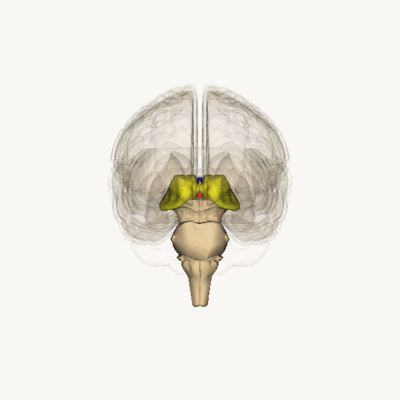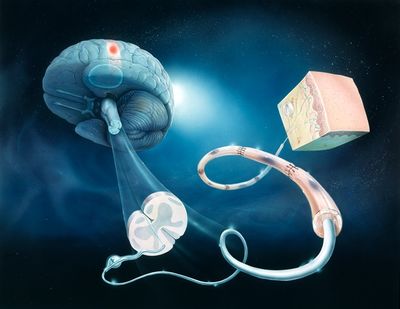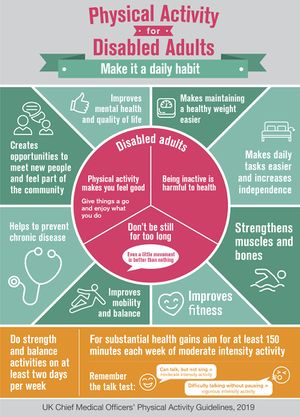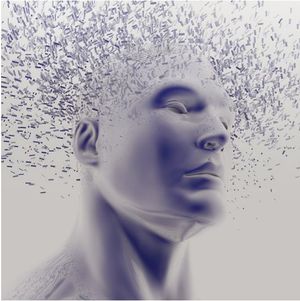Thalamus
Original Editor - Lucinda hampton
Top Contributors - Lucinda hampton, Kirenga Bamurange Liliane, Uchechukwu Chukwuemeka, Vidya Acharya and Mason Trauger
Introduction[edit | edit source]
The thalamus serves as the main relay station for the brain. Motor pathways, limbic pathways, and sensory pathways besides olfaction all pass through this central structure.
- The thalamus can divide into approximately 60 regions called nuclei. Each nucleus has unique pathways as inputs and various projections as outputs, most of which send information to the cerebral cortex.[1]
- Nestled beneath the cortex, the pair of egg-shaped structures called the thalamus have grown bigger and more complex throughout evolution (like the cerebral cortex), and its wiring became much more intricate as mammals diverged from reptiles.
- The thalamus (from the Greek thalamos or inner chamber) transmits 98 percent of sensory information to the cortex, including vision, taste, touch and balance; the only sense that doesn’t pass through this brain region is smell. The thalamus also conducts motor signals and relays information from the brain stem to the cortex, coordinating shifts in consciousness such as waking up and falling asleep.[2]
Image: Animation of rotation, brainstem and thalamus.
Functions[edit | edit source]
The thalamus is part of the limbic system, the region of the brain largely associated with the emotions and is essential to memory and learning.
The thalamus joins a series of other machinery whose purpose is to distill sensory information into a more interpretable and manageable form for higher brain sections. The thalamus is engaged in an intimate relationship with the cerebral cortex, with numerous mutual connections. These connections make up the thalamacortical loop. The thalamus also modulates arousal mechanisms, maintains alertness, and directs attention to sensory events.[3]
Functionally, the thalamus divides into five major functional components as:
- Reticular and intralaminar nuclei dealing with arousal and pain regulation. The reticular formation is constantly making intelligent guesses as to what sensory object is generating these activation patterns. The intralaminar circuit compares these pattern guesses with similar patterns in memory. All these circuits cooperate to produce a coherent framework for the interpretation of incoming sensory data.
- Sensory nuclei regulating all sensory domains except olfaction.
- Effector nuclei governing motor language function.
- Associative nuclei connoting cognitive functions.
- Limbic nuclei encompassing mood and motivation.[1]
These specific nuclei are responsible for scanning the cerebral cortex and determining active brain regions (those firing at around 40Hz) then relaying this information to the rest of the thalamus.[3]
Thalamus and Injury[edit | edit source]
The thalamus contributes to a broad range of critical functions. The side effects of thalamus damage can vary from person to person.
Some of the most common side effects of thalamic damage include:
- Sensory issues such as tingling, numbness, hypersensitivity, and pain
- Vision loss or light sensitivity
- Motor impairments
- Tremors
- Attention problems
- Memory loss
- Insomnia
- Impairments to proprioception
Additional presentations unique to thalamic injury involve:
- Thalamic pain syndrome: an excruciating sensation of pain unresponsive to narcotics. Once called Dejerine-Roussy Syndrome, this condition is commonly associated with infarct affecting the ventroposterolateral thalamus [4] [5]
- Pusher Syndrome: a lesion to the posterior thalamus interrupts a connection to the vestibular nuclei, leading to lateropulsion in the direction of the impaired side [6]
- Vegetative state and coma: a lesion to the non-specific (intralaminar and reticular) nuclei. [7] Coma may occur due to the thalamus's impacts on sleep and arousal[8]
Physiotherapy Treatment[edit | edit source]
Treatment for thalamic damage will revolve around restoring the abilities lost after brain injury. See the pages on Traumatic Brain Injury, Traumatic Brain Injury Clinical Guidelines, Physiotherapy Management of Traumatic Brain Injury, Physical Activity Guidelines for Traumatic Brain Injury.
What is the Mind?[edit | edit source]
Think about how the physical structure of the brain creates the metaphysical structure known as the mind.
Our thoughts are more than compilations of sensory inputs from the visual world, auditory world, olfactory world, tactile world and the world of taste. There is a long list of memories charged with emotional content that flavour our thoughts.
- Similar to “pop-ups” on a computer screen the thalamus “pops” information up to the cortex all the time. The cortex may serve as the screen on which the pop-ups appear, but who or what is watching the screen? Where that entity resides is a big question. Is the brain and the inputs it receives, both external and internal, part of a physical organ that is less than a greater organ, the mind. Or is our mind and in turn our behavior is controlled by the impulses our brain receives or by the controlling entity, the self.[9]
References[edit | edit source]
- ↑ 1.0 1.1 Torrico TJ, Munakomi S. Thalamus.2019 Available from:https://www.ncbi.nlm.nih.gov/books/NBK542184/ (accessed 26.12.2020)
- ↑ Knowable magazine A long-overlooked brain region may be key to complex thought Available from:https://knowablemagazine.org/article/mind/2018/long-overlooked-brain-region-may-be-key-complex-thought (accessed 26.12.2020)
- ↑ 3.0 3.1 WISE GEEK What is the Thalamus Available from:https://www.wisegeek.com/what-is-the-thalamus.htm (accessed 26.12.2020)
- ↑ Jahngir MU, Qureshi AI. Dejerine roussy syndrome.
- ↑ Dydyk AM, Munakomi S. Thalamic Pain Syndrome.[Updated 2023 Aug 13]. StatPearls [Internet]. Treasure Island (FL): StatPearls Publishing. 2023.
- ↑ Rosenzopf H, Klingbeil J, Wawrzyniak M, Röhrig L, Sperber C, Saur D, Karnath HO. Thalamocortical disconnection involved in pusher syndrome. Brain. 2023;146(9):3648-3661.
- ↑ Adams JH, Graham DI, Jennett B. The neuropathology of the vegetative state after an acute brain insult. Brain. 2000 Jul;123 (Pt 7):1327-38.
- ↑ Flint Rehab. Thalamus Injury: Symptoms, Treatment, and Recovery after Thalamic TBI Available from:https://www.flintrehab.com/thalamus-injury/ (accessed 26.12.2020)
- ↑ Think First The Thalamus Available from: https://www.thinkfirst.org/youth-lesson9 (accessed 26.12.2020)










